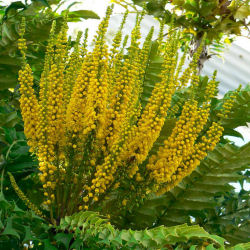Tall Oregon Grape, Mahonia aquifolium
Bush of the family Berberidaceae (the same family: Barberry)
 Etymology: The name Mahonia is a homage to the botanist, Bernard Mac Mahon (1775-1816). Origin Irishman, he had compromised himself in a rebellion against the British government and emigrated to America where he founded the botanical gardens of Philadelphia. "aquifolium" means "with holly leaves". This name alludes to the prickly form of the leaves of Mahonia. Etymology: The name Mahonia is a homage to the botanist, Bernard Mac Mahon (1775-1816). Origin Irishman, he had compromised himself in a rebellion against the British government and emigrated to America where he founded the botanical gardens of Philadelphia. "aquifolium" means "with holly leaves". This name alludes to the prickly form of the leaves of Mahonia.
Origin: West of North America. Mahonia was introduced into Europe in 1823.
The genus Mahonia includes about 90 species of shrubs native to Asia (Himalayas, China, Japan) and from North and Central America. This genus is very close to Thorns-Barberries genus Berberis, hence the intergeneric hybrid of horticultural origin x Mahobarberry.
Its English name, "Tall Oregon Grape", means "big grapes of Oregon". Mahonia became the emblem of the state of Oregon, which is its origin territory..
Habitat: Mahonia prefers humid and cool environments, in half shade. It makes the best of a shady habitat.
In its original area, Mahonia grows in the forests of big conifers (Douglasfir, Western red cedar), in undergrowth together with maples and with dogwoods notably.
Height: 1-2 m tall.
Bark: dark grey clearly.
Persistent foliage. Leaves alternate, imparipinnate, composed from 5 to 11 leaflets. Leaflets are tough, bright, with long petiole, of dark green colour. They take in autumn and in winter a sun-tanned or crimson nuance. Their margin is ruffled up from 4 to 12 prickly teeth on each side, a bit as on the holly leaf.
Flowers disposed on lengthened spikes ("racemes ") on which blossoming begins with the base and continues towards the apex (order acropetal). Racemes are born at the base of the young stems. Every flower has a form of cup, from 1 to 2 cm in diameters, of lemon yellow colour. They appear in December-January and resemble those of the thorn Barberry. They are fragrant and melliferous.
Fruits: bluish berries, about 1 cm in diameter, pruinose skin, lined up in pendulous clusters (under their weight). They are edible.
Advices of planting:
It is recommended to plant Mahonia in half-shade.
Prune (maintenance): pruning is not necessary, but it is possible to practice it after blossoming (March-April) to remove entangled branches, not to bother the deployment of flowers, to reduce the dimension of the shrub, or after a fall of leaves following an intense frost, to make resumption easier.
Toxicity:
Leaves and bark contain an alkaloid, a berberine, which is toxic. The noticed symptoms are troubles of bellies, vomiting (purgative effect) or tachycardia (effect hypotensor). The bark of roots is used in medicine. The fruits of Mahonia aquifolium do not contain alkaloid.
|

![]()

![]()

![]()